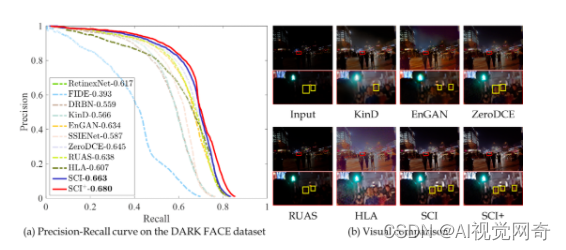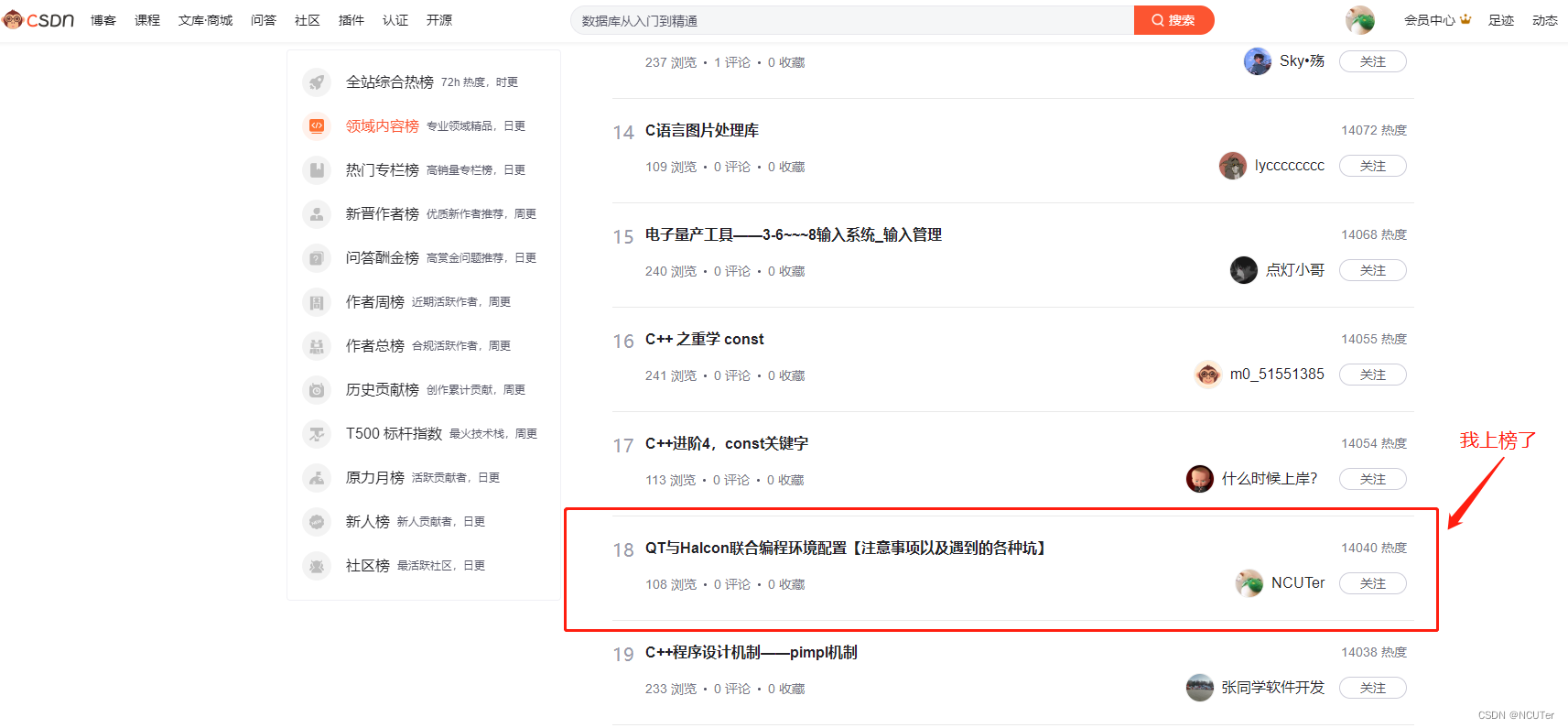当前位置:网站首页>CVPR 2022 oral Dalian Institute of technology proposed SCI: a fast and powerful low light image enhancement method
CVPR 2022 oral Dalian Institute of technology proposed SCI: a fast and powerful low light image enhancement method
2022-06-12 18:44:00 【AI vision netqi】
Three models easy.pt medium.pt difficult.pt, Every model 43k,
Toward Fast, Flexible, and Robust Low-Light Image Enhancement
The paper :https://arxiv.org/abs/2204.10137
Code :https://github.com/vis-opt-group/SCI
This paper presents a new low illumination image enhancement scheme : Self calibration illumination learning (SCI). By constructing a weight sharing illumination learning process that introduces a self calibration module , The complicated design process of network structure is abandoned , It achieves the purpose of using only simple operations for enhancement . A lot of experimental results show that ,SCI In visual quality 、 Computational efficiency 、 Breakthroughs have been made in the application of downstream visual tasks ( See the picture 1). The study has been CVPR 2022 Included as Oral.

chart 1 The results of this method are compared with those of other methods
Research background
Low illumination image enhancement is a classical task in image processing , It has received extensive attention in both academic and industrial circles .2018-2020 Three consecutive sessions of the UG2+Prize Challenge The competition will take low illumination face detection as the main competition unit , It has greatly promoted the academic research on low illumination image enhancement technology . A mobile phone manufacturer in 2019 The conference will focus on the dark light shooting ability , It has set off another wave of industry using deep learning technology to solve the problem of low illumination image enhancement .
Existing low light image enhancement techniques focus on building data-driven depth networks , Usually its network model is complex , Resulting in low computational efficiency 、 Reasoning is slow , And because of the dependence on the distribution of training data, its performance in unknown scenarios is not guaranteed . in general , The existing technology generally lacks practicality . To solve the above problems , This article focuses on learning strategies , Build a fast 、 Flexible and robust low illumination image enhancement scheme .
Methods of this paper
(1) Weight sharing illumination learning
according to Retinex theory , The low light observation image is equal to the dot product of the clear image and the light , namely

. In the design method based on this model , The estimation of illumination is usually regarded as the main optimization objective , After getting accurate illumination , Clear images can be obtained directly from the above relationship . Inspired by the stage by stage illumination optimization process of the existing work , In this paper, we construct a progressive lighting optimization process , Its basic units are as follows :

among

And respectively mean t Phase residuals and illumination . Represents the illumination estimation network . It should be noted that this is independent of the number of stages , That is, at each stage, the illumination estimation network keeps the shared state of structure and parameters . Further understanding of this module will lead to , Under the mechanism of progressive optimization and parameter sharing , Each stage wants to get output close to the goal . let me put it another way , Is there a possibility , Be able to make the output of each stage as close to and consistent with the goal as possible , thus , The multi-stage cascade test becomes the single-stage test , Will greatly reduce the cost of reasoning . To achieve this goal , A self calibration module is introduced as follows .

chart 2 The algorithm flow chart of this paper
(2) Self calibration module
The purpose of this module is to analyze the relationship between each stage , Ensure that the outputs at different stages of the training process can converge to the same state . The formula expression of the self calibration module is as follows :

among

It is the input for the next stage after calibration . in other words , The input of the second stage and later in the original illumination learning process has become the result of the above formula ( The overall calculation process is shown in the figure 2 Shown ), That is, the basic unit of the lighting optimization process is reformulated as :

actually , The self calibration module introduces physical laws ( namely Retinex theory ), The input of each stage is gradually corrected to indirectly affect the output of each stage , Then the convergence between stages is realized . chart 3 The function of self calibration module is explored , You can find , The introduction of self calibration module makes the results of different stages converge to the same state quickly ( That is, the results of the three stages coincide ).

chart 3 Whether to use the enhanced results of self calibration module in the test phase t-SNE Distribution comparison ( The number of stages is 3)
(3) Unsupervised loss function
In order to better train the proposed learning framework , This part designs an unsupervised loss function , To constrain the illumination estimation at each stage , The formula is as follows :

The former term and the latter term represent the data fidelity term and the smooth regularization term respectively ( For a detailed description of each variable, see the paper ).
experimental result
(1) quantitative analysis
surface 1 The famous MIT-Adobe FiveK Comparison of quantitative results on data sets , It can be seen that , The proposed method achieves optimal performance . It is worth noting that , Although the proposed method is unsupervised , But in the PSNR And SSIM The results of this kind of reference index are optimal , The reason lies in the Ground Truth It is decorated by experts , It also shows that the results generated by the proposed method are more in line with human visual habits .
surface 1 stay MIT-Adobe FiveK Comparison of quantitative results on data sets

(2) Visual contrast in real scenes
chart 4 It shows the comparison of enhancement results of two groups in difficult real scenes . It can be seen that , Compared with other methods , The proposed method has moderate brightness 、 Rich in details 、 Natural tone 、 With higher visual quality .

chart 4 Comparison of enhancement results in real scenes
(3) Downstream mission performance analysis
In order to further explore SCI The advantages of , This paper compares the performance of two downstream tasks, face detection in low light and semantic segmentation at night . In the task of low illumination face detection , It defines two kinds of and SCI Related versions , One is to SCI As a preprocessing, the brightness of the data is enhanced ( Other comparison methods adopt the same method ) And fine tune the detection network based on the data , The other is SCI Joint fine tuning with detection network ( Write it down as SCI+). chart 5 The test results are shown in , It can be seen that , The method proposed in this paper has obvious advantages , It can detect more small targets .

chart 5 Low light face detection results comparison
chart 6 It shows the performance of semantic segmentation at night , It can be seen that ,SCI The numerical results with competition are obtained , At the same time, it is more accurate in classification , More clear edge depiction .

chart 6 Comparison of semantic segmentation results at night
Summary and prospect
What this article puts forward SCI It has made a breakthrough in image quality and reasoning speed , It provides a new perspective for low illumination image enhancement , That is, how to endow the network model with stronger depiction ability under limited resources , It is believed that this perspective can also inspire other related visual enhancement fields . future , The author will continue to explore how to design more effective learning tools to build lightweight 、 Robust 、 A low illumination image enhancement scheme for more challenging real scenes .
边栏推荐
- 用一个性能提升了666倍的小案例说明在TiDB中正确使用索引的重要性
- 【sql语句基础】——查(select)(单表查询)
- Gd32f4xx communicates with electric energy meter conforming to dlt645_ two
- 2022.6.12-----leetcode.890
- Topic 66: input array, exchange the largest element with the first element, exchange the smallest element with the last element, and output array.
- 232-CH579M学习开发-以太网例程-TCP服务器(项目应用封装,局域网或广域网测试)
- 基于STM32设计智能家居控制系统(OneNet)_2022
- Mysql ->>符号用法 Json相关
- Adjust CEPH cluster image source
- Leetcode 494. Objectives and
猜你喜欢

间隔两个月,我的第二次上榜纪念日【2022.6.2】

基于Halcon的螺栓螺丝部分划痕、腐蚀缺陷检测
![leetcode:6097. Match [set record + query one by one with the same length] after replacing characters](/img/03/d8286742bacf25b62c7dc3dcb0733e.png)
leetcode:6097. Match [set record + query one by one with the same length] after replacing characters
![leetcode:5270. Minimum path cost in Grid [simple level DP]](/img/c5/37fd1878e92f95340926e0ea75f150.png)
leetcode:5270. Minimum path cost in Grid [simple level DP]
![leetcode:98. Count the number of subarrays whose score is less than k [double pointers + number of calculated subsets + de duplication]](/img/97/67d74ae93be2cd4c0153a764cbe4c1.png)
leetcode:98. Count the number of subarrays whose score is less than k [double pointers + number of calculated subsets + de duplication]

CVPR 2022 Oral 大连理工提出SCI:快速、超强的低光照图像增强方法

Pytest automated testing framework (II)

Kali implements port forwarding through iptables
![[blockbuster release] ant dynamic card, enabling the app home page to realize agile update](/img/65/5ed80090f4d0ee92b01888eb496528.jpg)
[blockbuster release] ant dynamic card, enabling the app home page to realize agile update

吃饭咯 干锅肥肠 + 掌中宝!
随机推荐
Voir les pages du site
C语言学习——数据在内存中的存储
Gd32f4xx controls dgus touch keys
dumi 搭建文档型博客
leetcode:6097. Match [set record + query one by one with the same length] after replacing characters
MySQL - > > symbol usage JSON related
OpenGL shadow implementation (soft shadow)
Gospel of audio and video developers, rapid integration of AI dubbing capability
Analyzing mobx responsive refresh mechanism from source code
Gd32f4xx controls dgus variable display
kali局域网ARP欺骗(arpspoof)并监听(mitmproxy)局域内其它主机上网记录
A story on the cloud of the Centennial Olympic Games belonging to Alibaba cloud video cloud
从应无所住说起
C language practice (4) -- multiplication and division of large numbers
基于STM32设计智能家居控制系统(OneNet)_2022
How to download Vega in China
leetcode:6096. 咒语和药水的成功对数【排序 + 二分】
Mise en œuvre de l'ACL réflexe dans le simulateur Cisco Cisco Packet Tracer
Basic SQL statement - select (single table query)
间隔两个月,我的第二次上榜纪念日【2022.6.2】